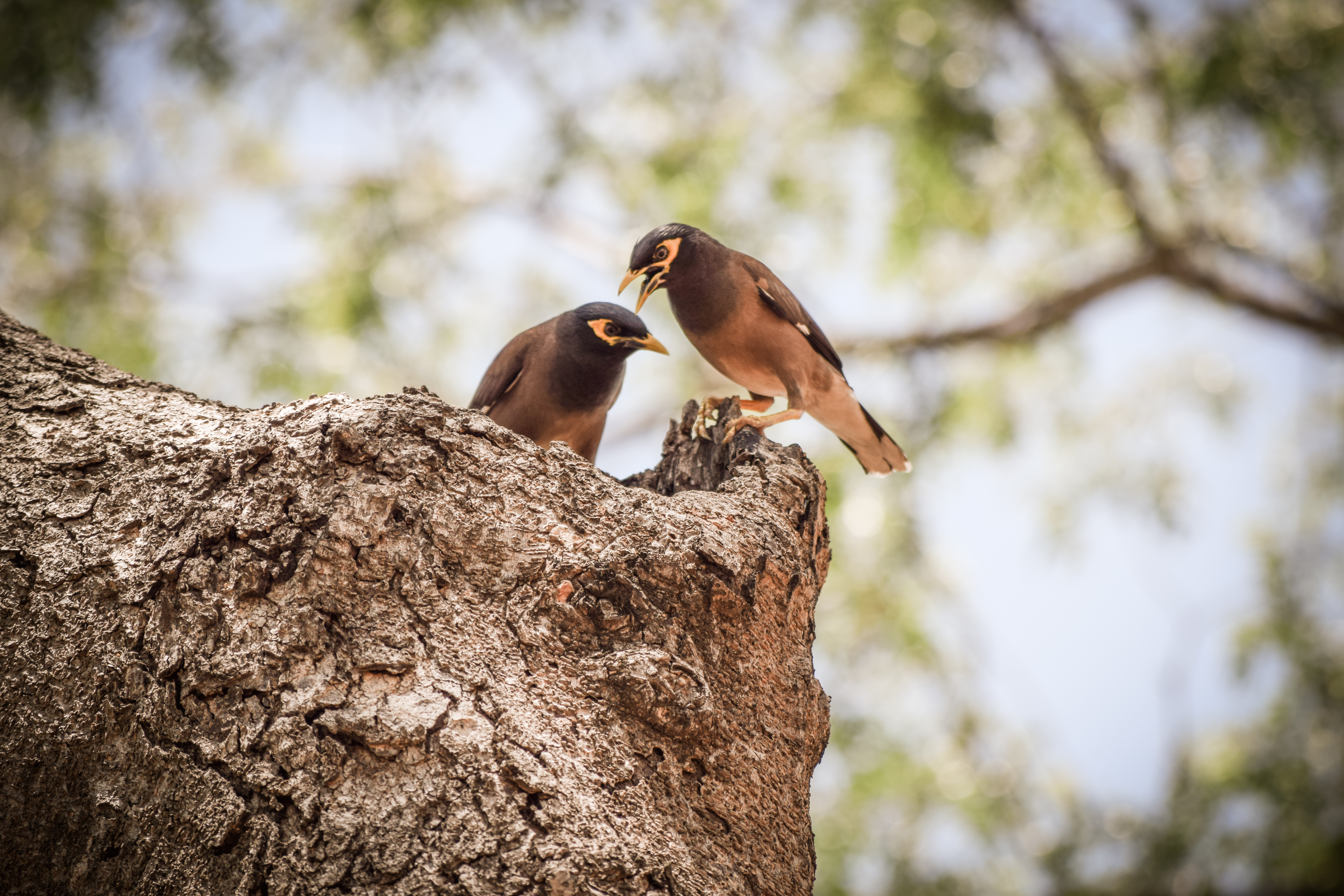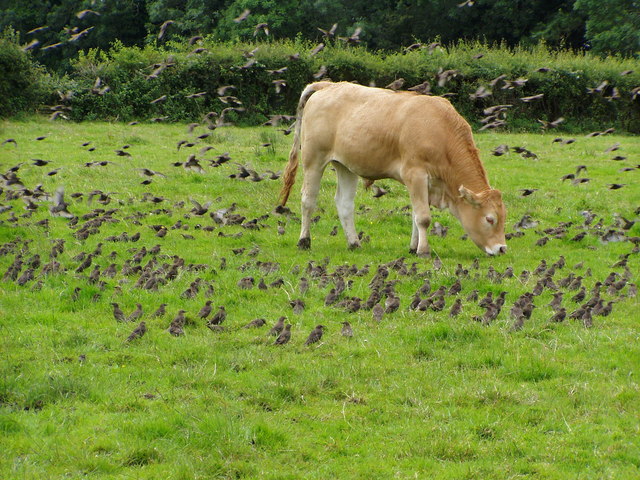|
Mynas
The mynas (; also spelled mynah) are a group of birds in the starling family (Sturnidae). This is a group of passerine birds which are native to Iran and Southern Asia, especially Afghanistan, India, Pakistan, Bangladesh, Nepal and Sri Lanka. Several species have been introduced to areas like North America, Australia, South Africa, Fiji and New Zealand, especially the common myna, which is often regarded as an invasive species. It is often known as "Selarang" and "Teck Meng" in Malay and Chinese respectively in Singapore, due to their high population there. Mynas are not a natural group; instead, the term ''myna'' is used for any starling in the Indian subcontinent, regardless of their relationships. This range was colonized twice during the evolution of starlings, first by rather ancestral starlings related to the coleto and ''Aplonis'' lineages, and millions of years later by birds related to the common starling and wattled starling's ancestors. These two groups of mynas ... [...More Info...] [...Related Items...] OR: [Wikipedia] [Google] [Baidu] |
Common Myna
The common myna or Indian myna (''Acridotheres tristis''), sometimes spelled mynah, is a bird in the Family (biology), family Sturnidae, native to Asia. An omnivorous open woodland bird with a strong territorial instinct, the common myna has adapted extremely well to Urban area, urban environments. The range of the common myna is increasing at such a rapid rate that in 2000 the IUCN Species Survival Commission declared it one of the world's most invasive species and one of only three birds listed among "100 of the World's Worst Invasive Alien Species, 100 of the World's Worst Invasive Species" that pose a threat to biodiversity, agriculture and human interests. In particular, the species poses a serious threat to the ecosystems of Australia, where it was named "The Most Important Pest/Problem" in 2008. Taxonomy In 1760, the French zoologist Mathurin Jacques Brisson included a description of the common myna in his ''Ornithologie'', based on a specimen that he mistakenly believed ... [...More Info...] [...Related Items...] OR: [Wikipedia] [Google] [Baidu] |
Bali Myna
The Bali myna (''Leucopsar rothschildi''), also known as Rothschild's mynah, Bali starling, or Bali mynah, locally known as jalak Bali, is a medium-sized (up to long), stocky myna, almost wholly white with a long, drooping crest, and black tips on the wings and tail. The bird has blue bare skin around the eyes, greyish legs and a yellow Beak, bill. Both sexes are similar. It is critically endangered and in 2020, fewer than 50 adults were assumed to exist in the wild.BirdLife International. 2020. ''Leucopsar rothschildi''. The IUCN Red List of Threatened Species 2021: e.T22710912A183006359. https://dx.doi.org/10.2305/IUCN.UK.2021-3.RLTS.T22710912A183006359.en. Accessed on 27 April 2023. Taxonomy and systematics The Bali myna was species description, formally described in 1912 by the German ornithologist Erwin Stresemann based on a female specimen collected on the island of Bali in Indonesia. He introduced a new genus ''Leucopsar'' and coined the binomial name ''Leucopsar rothsch ... [...More Info...] [...Related Items...] OR: [Wikipedia] [Google] [Baidu] |
Starling
Starlings are small to medium-sized passerine (perching) birds known for the often dark, glossy iridescent sheen of their plumage; their complex vocalizations including mimicking; and their distinctive, often elaborate swarming behavior, known as murmuration. All members of the family ''Sturnidae'', commonly called sturnids, are known collectively as starlings. The Sturnidae are named for the genus '' Sturnus'', which in turn comes from the Latin word for starling, ''sturnus''. The family contains 128 species which are divided into 36 genera. Many Asian species, particularly the larger ones, are called mynas, and many African species are known as glossy starlings because of their iridescent plumage. Starlings are native to Europe, Asia, and Africa, as well as northern Australia and the islands of the tropical Pacific. Several European and Asian species have been introduced to these areas, as well as North America, Hawaii, and New Zealand, where they generally compete for ... [...More Info...] [...Related Items...] OR: [Wikipedia] [Google] [Baidu] |
Wattled Starling
The wattled starling (''Creatophora cinerea'') is a nomadic resident bird in eastern and southern Africa. It is a species of grassland, open woodland, and cultivation. This is the only African starling that appears to show affinities with the Asian starlings, particularly the genus ''Sturnus''. Its bare face patches and ability to open-bill feed in grassland are unique amongst African starlings. It is the only member of the genus ''Creatophora''. This common species appears to be extending its range into West Africa and has also occurred in Arabia, Madagascar, and Seychelles. Description The wattled starling is 21 cm long, with a short tail and pointed wings. It has mainly grey plumage except for a white rump, and black flight feathers and tail. The breeding male has a white shoulder patch and a distinctive head pattern, with unfeathered yellow skin, and black forehead and throat wattles. The extent to which these seasonal features develop increases with the age of the bir ... [...More Info...] [...Related Items...] OR: [Wikipedia] [Google] [Baidu] |
Common Starling
The common starling (''Sturnus vulgaris''), also known simply as the starling in Great Britain and Ireland, and as European starling in North America, is a medium-sized passerine bird in the starling family, Sturnidae. It is about long and has glossy black plumage with a metallic sheen, which is speckled with white at some times of the year. The legs are pink and the bill is black in winter and yellow in summer; young birds have browner plumage than the adults. Its gift for mimicry has been noted in literature including the ''Mabinogion'' and the works of Pliny the Elder and William Shakespeare. The common starling has about 12 subspecies breeding in open habitats across its native range in temperate Europe and across the Palearctic to western Mongolia, and it has been introduced as an invasive species to Australia, New Zealand, Canada, the United States, Mexico, Argentina, South Africa and Fiji. This bird is resident in western and southern Europe and southwestern Asia, whil ... [...More Info...] [...Related Items...] OR: [Wikipedia] [Google] [Baidu] |
Aplonis
''Aplonis'' is a genus of starlings. These are essentially island species of Indonesia and Oceania, although some species' ranges extend to the Malay Peninsula, southern Vietnam and northeastern Queensland. The typical adult ''Aplonis'' starling is fairly uniformly plumaged in black, brown or dark green, sometimes with a metallic gloss. The eye ring is often distinctively coloured. Immatures of several species have dark streaked pale underparts. Several species have restricted ranges, and, like other island endemics, have become endangered or extinct as a result of habitat loss or introduced mammals such as rats. Taxonomy The genus ''Aplonis'' was introduced in 1836 by the English ornithologist John Gould. He listed two species in the new genus but did not specify which was the type species. In 1840 George Gray designated the ''Aplonis fusca'' Gould 1836 as the type. This is the extinct Tasman starling. The genus name is from Ancient Greek ''haploos '' meaning "simple" or "plain ... [...More Info...] [...Related Items...] OR: [Wikipedia] [Google] [Baidu] |
New Zealand
New Zealand () is an island country in the southwestern Pacific Ocean. It consists of two main landmasses—the North Island () and the South Island ()—and List of islands of New Zealand, over 600 smaller islands. It is the List of island countries, sixth-largest island country by area and lies east of Australia across the Tasman Sea and south of the islands of New Caledonia, Fiji, and Tonga. The Geography of New Zealand, country's varied topography and sharp mountain peaks, including the Southern Alps (), owe much to tectonic uplift and volcanic eruptions. Capital of New Zealand, New Zealand's capital city is Wellington, and its most populous city is Auckland. The islands of New Zealand were the last large habitable land to be settled by humans. Between about 1280 and 1350, Polynesians began to settle in the islands and subsequently developed a distinctive Māori culture. In 1642, the Dutch explorer Abel Tasman became the first European to sight and record New Zealand. ... [...More Info...] [...Related Items...] OR: [Wikipedia] [Google] [Baidu] |
Insect
Insects (from Latin ') are Hexapoda, hexapod invertebrates of the class (biology), class Insecta. They are the largest group within the arthropod phylum. Insects have a chitinous exoskeleton, a three-part body (Insect morphology#Head, head, Thorax (insect anatomy), thorax and abdomen (insect anatomy), abdomen), three pairs of jointed Arthropod leg, legs, compound eyes, and a pair of antenna (biology), antennae. Insects are the most diverse group of animals, with more than a million described species; they represent more than half of all animal species. The insect nervous system consists of a insect brain, brain and a ventral nerve cord. Most insects reproduce Oviparous, by laying eggs. Insects Respiratory system of insects, breathe air through a system of Spiracle (arthropods), paired openings along their sides, connected to Trachea#Invertebrates, small tubes that take air directly to the tissues. The blood therefore does not carry oxygen; it is only partly contained in ves ... [...More Info...] [...Related Items...] OR: [Wikipedia] [Google] [Baidu] |
Sanskrit
Sanskrit (; stem form ; nominal singular , ,) is a classical language belonging to the Indo-Aryan languages, Indo-Aryan branch of the Indo-European languages. It arose in northwest South Asia after its predecessor languages had Trans-cultural diffusion, diffused there from the northwest in the late Bronze Age#South Asia, Bronze Age. Sanskrit is the sacred language of Hinduism, the language of classical Hindu philosophy, and of historical texts of Buddhism and Jainism. It was a lingua franca, link language in ancient and medieval South Asia, and upon transmission of Hindu and Buddhist culture to Southeast Asia, East Asia and Central Asia in the early medieval era, it became a language of religion and high culture, and of the political elites in some of these regions. As a result, Sanskrit had a lasting effect on the languages of South Asia, Southeast Asia and East Asia, especially in their formal and learned vocabularies. Sanskrit generally connotes several Indo-Aryan languages# ... [...More Info...] [...Related Items...] OR: [Wikipedia] [Google] [Baidu] |
Extinct
Extinction is the termination of an organism by the death of its Endling, last member. A taxon may become Functional extinction, functionally extinct before the death of its last member if it loses the capacity to Reproduction, reproduce and recover. As a species' potential Range (biology), range may be very large, determining this moment is difficult, and is usually done retrospectively. This difficulty leads to phenomena such as Lazarus taxon, Lazarus taxa, where a species presumed extinct abruptly "reappears" (typically in the Fossil, fossil record) after a period of apparent absence. Over five billion species are estimated to have died out. It is estimated that there are currently around 8.7 million species of eukaryotes globally, possibly many times more if microorganisms are included. Notable extinct animal species include Dinosaur, non-avian dinosaurs, Machairodontinae, saber-toothed cats, and mammoths. Through evolution, species arise through the process of specia ... [...More Info...] [...Related Items...] OR: [Wikipedia] [Google] [Baidu] |








